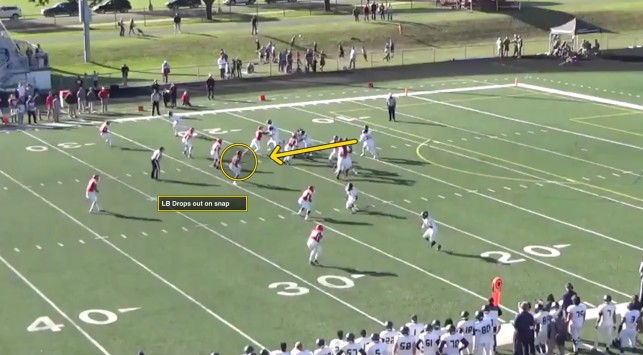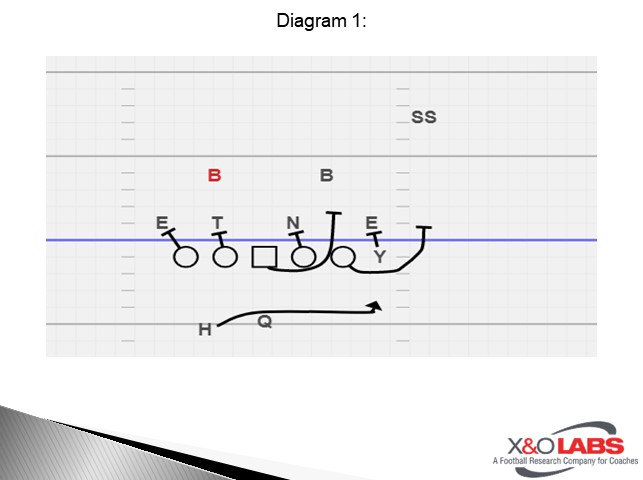By Phil Hamilton
Offensive Coordinator
Saint Vincent College (PA)
Twitter: @coachphamilton
Adaptability is so important in today’s fast-moving society. It is also vital on the football field. Defenses have slowly but surely adapted to the “RPO” world we currently play in. Having the ability to continually keep a defense on their toes is always at the forefront of our offensive game plan. RPOs and Play-Action Passes are an integral part of our system. Because of this, adapting and enhancing the run game, while incorporating passes off of it, has been imperative. With the idea of keeping a defense aggressive, using pullers is effective.

Essential Coaching Points:
The first essential coaching point of any RPO or Play Action Pass is ball-handling. When we start this process in practice, our quarterbacks must understand the importance of making everything look exactly like run. Defensive players, at their core, are just like dogs; if you show them a piece of meat, they will run to it. The quarterback must treat every RPO or Play Action Pass as if we are handing the ball off. When it comes to the RPOs, we stress the importance of riding the ball hip to hip. This gives the quarterback ample time to make his read, for the defensive player to react, and for him to make an educated decision on what to do with the football. When the quarterback gets a pull read, we want to stress being “violent” with the football. Rip the ball up into a perfect stance and let it rip! If he hands the ball off, we stress the same things--carry out your fake!
The second essential coaching point is the demeanor of the offensive line. Just as the QB does, the OL must treat RPOs and Play Action Passes just as we would any run play. With the leeway that they receive to push up to three yards downfield, they have plenty of room to block for the run while keeping their boundaries in the back of their mind. Coming off the ball with aggression is key.
The third essential coaching point is the demeanor of the running back. At the risk of sounding like a broken record, the running back must treat these types of plays like he is getting the ball. In the RPO game, the running back has a very good chance to receive a hand-off, so whether he does or not, we want him to go through his read process; carry out the fake as if you have the football. If the RB attacks his aiming point and cuts off his blocks, he is always able to get reps at reading the run game, even if he does not have the football. With all fakes, if we are able to take one defensive player out of the play, the job has been accomplished.
Pin and Pull Concept:
Pin & Pull is a great way to get our big guys blocking smaller guys. It takes some athleticism for the OL, but it also gives our running backs a way to get into open space quickly. Being able to incorporate run/pass options off of Pin & Pull has helped us tremendously. There are several ways we can do it. We always want to identify an aggressive defensive player. Whatever level we are attacking, we want the defense to return to their core identity: aggression. With their aggressive nature, we gain numbers in the passing game. If they are coached to take a more passive approach, we will have favorable numbers in the run game. Pullers tend to emphasize run and bring out that aggression, especially when multiple guys are pulling.
Reading a Linebacker:

When we have identified the read linebacker, our next step in design is the pass concept. When reading a linebacker, we always would like to have something quick behind it. We love to keep our quarterback in a 1 to 2 read. Give him two options. Throw the first, until it is taken away. Shift your hips and throw the second. As a quarterback, we have to know that the OL is not pass-blocking! The read and throw must be quick. In both of these examples, you see the quick hitters we have in place behind the linebackers. The aggression of the linebackers is accentuated by the pulling action. In both cases, each linebacker is sucked in by the action, leaving great throwing lanes.
To study game film of these RPO concepts, click on the video below:
Editor’s Note: Coach Hamilton has provided clip by clip narration of this playlist below.
The first, double slants, is good against man or zone coverage. Although we lose a man up front, the quarterback does a great job of maintaining his base and moving to his second option. The first window is open, but because he has to move, he throws the outside slant.
In the second clip, you see the backer in the box drop at the snap. This is great for us. Most linebackers trigger when they see pullers. In this case, his aggression has been taken away. By dropping out, we now have a hat on a hat.
In the third clip, we receive heavy pressure off the edge. Blitz provides us two ways out; make the quick decision to throw or hand the ball off to and not take a hit. In any offense, limiting quarterback hits is essential. The quarterback does a great job of making the decision to hand the ball off.
The fourth example is a slant/bubble concept. Again, this can be used against man or zone coverage. Our receiver does a great job of attacking leverage and causing the defenders to collide in man coverage. The route is great, but the quarterback performs perfectly here as well. He gives great ball action, riding it hip to hip. That action allows the defense to react. Being inside the ten-yard line helps as well, attacking the aggressive nature of the defense in the red zone.
The fifth clip is gray. The quarterback makes the decision to give the ball because of the linebacker whom we are reading "slow plays" it. Being decisive is huge in this offense, and the quarterback does a good job with that here.
Offensive Coordinator
Saint Vincent College (PA)
Twitter: @coachphamilton
Adaptability is so important in today’s fast-moving society. It is also vital on the football field. Defenses have slowly but surely adapted to the “RPO” world we currently play in. Having the ability to continually keep a defense on their toes is always at the forefront of our offensive game plan. RPOs and Play-Action Passes are an integral part of our system. Because of this, adapting and enhancing the run game, while incorporating passes off of it, has been imperative. With the idea of keeping a defense aggressive, using pullers is effective.

Essential Coaching Points:
The first essential coaching point of any RPO or Play Action Pass is ball-handling. When we start this process in practice, our quarterbacks must understand the importance of making everything look exactly like run. Defensive players, at their core, are just like dogs; if you show them a piece of meat, they will run to it. The quarterback must treat every RPO or Play Action Pass as if we are handing the ball off. When it comes to the RPOs, we stress the importance of riding the ball hip to hip. This gives the quarterback ample time to make his read, for the defensive player to react, and for him to make an educated decision on what to do with the football. When the quarterback gets a pull read, we want to stress being “violent” with the football. Rip the ball up into a perfect stance and let it rip! If he hands the ball off, we stress the same things--carry out your fake!
The second essential coaching point is the demeanor of the offensive line. Just as the QB does, the OL must treat RPOs and Play Action Passes just as we would any run play. With the leeway that they receive to push up to three yards downfield, they have plenty of room to block for the run while keeping their boundaries in the back of their mind. Coming off the ball with aggression is key.
The third essential coaching point is the demeanor of the running back. At the risk of sounding like a broken record, the running back must treat these types of plays like he is getting the ball. In the RPO game, the running back has a very good chance to receive a hand-off, so whether he does or not, we want him to go through his read process; carry out the fake as if you have the football. If the RB attacks his aiming point and cuts off his blocks, he is always able to get reps at reading the run game, even if he does not have the football. With all fakes, if we are able to take one defensive player out of the play, the job has been accomplished.
Pin and Pull Concept:
Pin & Pull is a great way to get our big guys blocking smaller guys. It takes some athleticism for the OL, but it also gives our running backs a way to get into open space quickly. Being able to incorporate run/pass options off of Pin & Pull has helped us tremendously. There are several ways we can do it. We always want to identify an aggressive defensive player. Whatever level we are attacking, we want the defense to return to their core identity: aggression. With their aggressive nature, we gain numbers in the passing game. If they are coached to take a more passive approach, we will have favorable numbers in the run game. Pullers tend to emphasize run and bring out that aggression, especially when multiple guys are pulling.
Reading a Linebacker:

When we have identified the read linebacker, our next step in design is the pass concept. When reading a linebacker, we always would like to have something quick behind it. We love to keep our quarterback in a 1 to 2 read. Give him two options. Throw the first, until it is taken away. Shift your hips and throw the second. As a quarterback, we have to know that the OL is not pass-blocking! The read and throw must be quick. In both of these examples, you see the quick hitters we have in place behind the linebackers. The aggression of the linebackers is accentuated by the pulling action. In both cases, each linebacker is sucked in by the action, leaving great throwing lanes.
To study game film of these RPO concepts, click on the video below:
Editor’s Note: Coach Hamilton has provided clip by clip narration of this playlist below.
The first, double slants, is good against man or zone coverage. Although we lose a man up front, the quarterback does a great job of maintaining his base and moving to his second option. The first window is open, but because he has to move, he throws the outside slant.
In the second clip, you see the backer in the box drop at the snap. This is great for us. Most linebackers trigger when they see pullers. In this case, his aggression has been taken away. By dropping out, we now have a hat on a hat.
In the third clip, we receive heavy pressure off the edge. Blitz provides us two ways out; make the quick decision to throw or hand the ball off to and not take a hit. In any offense, limiting quarterback hits is essential. The quarterback does a great job of making the decision to hand the ball off.
The fourth example is a slant/bubble concept. Again, this can be used against man or zone coverage. Our receiver does a great job of attacking leverage and causing the defenders to collide in man coverage. The route is great, but the quarterback performs perfectly here as well. He gives great ball action, riding it hip to hip. That action allows the defense to react. Being inside the ten-yard line helps as well, attacking the aggressive nature of the defense in the red zone.
The fifth clip is gray. The quarterback makes the decision to give the ball because of the linebacker whom we are reading "slow plays" it. Being decisive is huge in this offense, and the quarterback does a good job with that here.








